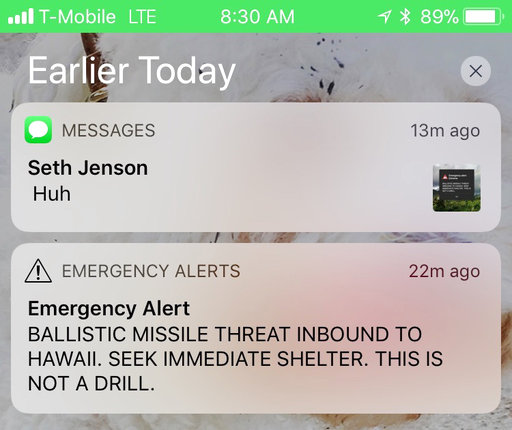Hawaii missile alert sent Americans in panic

This smartphone screen capture shows a false incoming ballistic missile emergency alert sent from the Hawaii Emergency Management Agency system on Saturday, Jan. 13, 2018. (AP Photo/Marco Garcia)
On Saturday, Hawaiians faced an alarming situation as they were notified that there was a ballistic missile threat. The message told citizens “Ballistic missile threat inbound to Hawaii. Seek immediate shelter. This is not a drill.” This message was sent out by the Hawaiian Emergency Management Agency (HI-EMA) to all phones and televisions on the Islands. This error, which was corrected 38 minutes later, sent Hawaiians, tourists, and the rest of America into a brief panic.
After an internal investigation by the Hawaii Emergency Management Agency, it was discovered that this mistake occurred due to human error. In a press conference later in the day, the Administrator of the Agency Vern Miyagi, said that “the wrong button was pushed” during a standard internal drill by the agency. After the messages began to be sent out, there was no way to correct the mistake immediately. As the message continued to be sent out, sirens began to sound. The use of sirens was not authorized by either Miyagi or Governor David Ige, and they furthered the panic on the islands. The message that was played on television stated “If you are outdoors, seek immediate shelter in a building. Remain indoors well away from windows. If you are driving, pull safely to the side of the road and seek shelter in a nearby building or lie on the floor. We will announce when the threat has ended.” The HI-EMA went through the necessary steps to recall the announcement as quickly as possible.
The message also prompted several national security agencies to release a statement on the issue. The Pentagon and the Pacific Command both issued statements that there was no ballistic missile threat to Hawaii, and that the region was safe.
The threat of a possible nuclear weapon launch in the Pacific region has been an emotional reality as tensions continue to build between Western Powers and North Korea. In the past year North Korea has launched missile tests and has tested nuclear weapons within their country, and often over Japan. With a lack of diplomatic progress thus far with the Kim Jong-un regime, both sides have increased military presence in the region. With the thought of nuclear attack looming due to the volatility of North Korea, Hawaiians had a reason to be legitimately fearful.
Politicians were fast to comment on the situation and how it relates to the conflict with North Korea. Democratic Representative from Hawaii Tulsi Gabbard believes President Trump should treat the escalating situation with more care in order to avoid this type of situation in the future.
“I’ve been calling on President Trump to directly negotiate with North Korea without preconditions, to sit across the table from Kim Jong-un, work out the differences so that we can build a pathway towards denuclearization to remove the threat,” said Gabbard in a statement made on Twitter.
President Trump also made a statement the next day regarding the events in Hawaii.
“We hope it won’t happen again. But part of it is that people are on edge, but maybe, eventually, we’ll solve the problem so they won’t have to be so on edge,” President Trump stated while with Senate Majority leader Kevin McCarthy, referring to the strained relationship with North Korea.
After this tense situation for Hawaiians, a step in the direction of diplomacy with North Korea is likely to be considered. Even though the ballistic missile threat alert was caused by human error, the threat was probable enough to be considered valid and real. Many Americans will recognize the situation in Hawaii as a step back in time to the Cold War era when nuclear war seemed inevitable and taking shelter from the totalitarian regime was a regular occurrence. The situation with North Korea will continue to be examined in order to avoid these same patterns.

